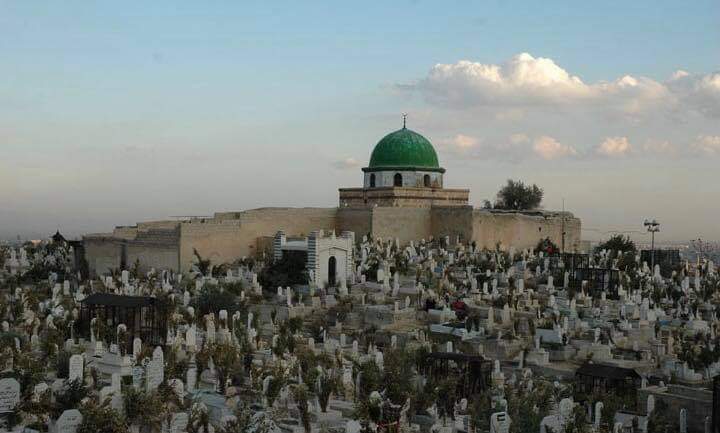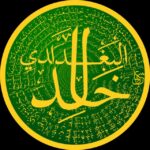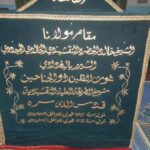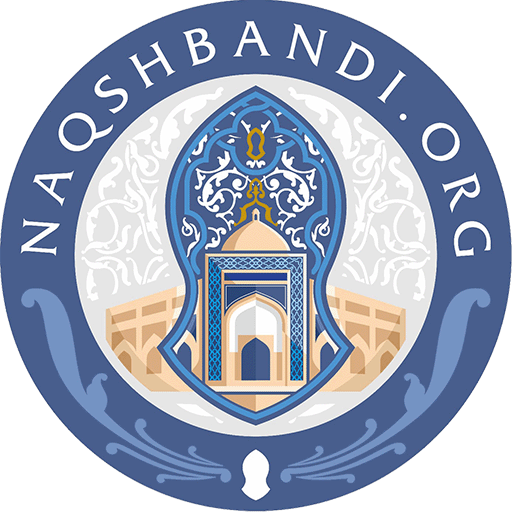
He praises me, and I praise Him;
He serves me, and I serve Him;
By my existence I affirm Him;
And by my determination I deny Him;
It is He who knows me, when I deny Him;
Then I discover Him and contemplate Him.
He was the Scholar of Scholars and the Saint of Saints and the Knower of Knowers and the Light and the Full Moon of this Order in his time. He was the Keeper of the Secrets of Realities and the Realities of the Secrets. His secrets moved into every human being just as the soul moves into the body. If the Prophet ![]() had not been the Seal of Prophecy his words would have been revelation. He spread the knowledge of both Islamic law and Tasawwuf. He was a mujtahid(authority) in Divine Law (shari`a) and in Divine Reality (حقيقت). He was the Scholar of the Perfect Saints and He was the Saint of the Perfect Scholars. He achieved all the spiritual and the worldly knowledge. He learned the branches and the trunk. He was the Center of the Circle of Qutbs in his time and he was the means of merging the ends with the beginnings and the beginnings with the ends. He was the Reviver of the 13th Century of the Hijra. The Universe was proud of his existence.
had not been the Seal of Prophecy his words would have been revelation. He spread the knowledge of both Islamic law and Tasawwuf. He was a mujtahid(authority) in Divine Law (shari`a) and in Divine Reality (حقيقت). He was the Scholar of the Perfect Saints and He was the Saint of the Perfect Scholars. He achieved all the spiritual and the worldly knowledge. He learned the branches and the trunk. He was the Center of the Circle of Qutbs in his time and he was the means of merging the ends with the beginnings and the beginnings with the ends. He was the Reviver of the 13th Century of the Hijra. The Universe was proud of his existence.
He was born in the year 1193 H./1779 CE. in the village of Karada of the city of Sulaymaniyyah in Iraq. He was raised and trained in that city, where there were many schools and many mosques and which was considered the primary educational city of his time. His grandfather was Pir Mika’il Chis Anchit, which means Mika’il the Saint of the six fingers. His title is `Uthmani because he is a descendant of Sayyidina `Uthman ibn `Affan ![]() , the third khalif of the Prophet
, the third khalif of the Prophet ![]() .
.
He studied the Qur’an and the explanation of Imam Rafi`a according to the Shafi`i school. He was famous in poetry. When he was fifteen years of age he took asceticism as his creed, hunger as his horse, wakefulness as his means, seclusion as his friend, and energy as his light. He was a traveler in Allah’s World and he achieved all the kinds of knowledge available in his time. He studied with the two great scholars of his time, Shaykh `Abdul Karam al-Barzinji and Shaykh Abdur Rahim al-Barzinji, and he read with Mullah Muhammad `Ali . He returned to Sulaymaniyyah and there studied the Sciences of mathematics, philosophy, and logic. Then he came to Baghdad and studied the Mukhtasar al-Muntaha fil-Usul, an encyclopedia of the Principles of Jurisprudence. Then he studied the works of Ibn Hajar, Suyuti, and Haythami. He memorized the commentary of the Qur’an of Baydawi. He was able to find solutions for even the most difficult questions in jurisprudence. He memorized the Qur’an according to the fourteen different ways of recitation, and became very famous everywhere for this. The Prince Ihsan Ibrahim Pasha, the governor of Baban, tried to persuade him to look after the schools in his kingdom. However, he refused and moved to the city of Sanandaj, where he studied the Sciences of mathematics, engineering, astronomy, and chemistry.
His teacher in these disciplines was Muhammad al-Qasim as-Sanandaji. After completing the study of the secular sciences he returned to the city of Sulaymaniyyah. Following the plague of 1213 H/1798 AD., he took over the school of his Shaykh `Abdul Karam Barzinji. He taught the modern sciences, verifying the most delicate equations of astronomy and chemistry.
He then entered seclusion, leaving everything he had studied behind, coming to Allah’s door with all kinds of pious actions and much ذِكْر, both loud and silent. He no longer visited the sultans, but kept to himself and to his murids, until the year 1220 H./1806 AD. when he decided to make the Pilgrimage and to visit the Prophet ![]() . He left everything and went to Hijaz through the cities of Mosul and Yarbikir and ar-Raha and Aleppo and Damascus, where he met its scholars and followed its Shaykh, the master of both the ancient and the modern knowledge and the teacher of hadith, ash-Shaykh Muhammad al-Kuzbara. He received authorization in the Qadiri Tariqat from Shaykh al-Kuzbari and his deputy, Shaykh Mustafa al-Kurdi, who travelled with him until he reached the city of the Prophet
. He left everything and went to Hijaz through the cities of Mosul and Yarbikir and ar-Raha and Aleppo and Damascus, where he met its scholars and followed its Shaykh, the master of both the ancient and the modern knowledge and the teacher of hadith, ash-Shaykh Muhammad al-Kuzbara. He received authorization in the Qadiri Tariqat from Shaykh al-Kuzbari and his deputy, Shaykh Mustafa al-Kurdi, who travelled with him until he reached the city of the Prophet ![]() . He praised the Prophet in Persian poetry in such a way that people were astonished at his eloquence. He spent a long time in the City of the Prophet
. He praised the Prophet in Persian poetry in such a way that people were astonished at his eloquence. He spent a long time in the City of the Prophet ![]() . He reported:
. He reported:
“I was looking for someone of rare piety in order to take some advice when I saw a Shaykh on the right-hand side of the Blessed Gravesite (Rawdatu-sh-Sharifa). I asked him to give me advice, counsel from a wise scholar to an ignorant person. He advised me not to object when I enter Makkah to matters which might appear to be counter to the Shari`a, but to keep quiet. I reached Makkah, and keeping in my heart that advice, I went to the Holy Mosque early on the morning of Friday. I sat near the Ka’ba reading Dala’il al-Khayrat, when I saw a man with a black beard leaning on a pillar and looking at me. It came to my heart that the man was not showing the proper respect to the Ka`ba, but I didn’t say anything to him about the matter. “He looked at me and scolded me, saying, ‘O ignorant one, don’t you know that the honor of the heart of a believer is far more than the privilege of the Ka`ba? Why do you criticize me in your heart for standing with my back to the Ka`ba and my face to you. Didn’t you hear the advice of my Shaykh in Madinah who told you not to criticise?’ I ran to him and asked his forgiveness, kissing his hands and feet and asking him for his guidance to Allah. He told me, ‘O my son, your treasures and the keys to your heart are not in these parts, but in India. Your Shaykh is there. Go there and he will show you what you have to do.’ I didn’t see anyone better than him in all the Haram. He didn’t tell me where to go in India, so I went back to Sham and associated with its scholars.”
He then returned to Sulaymaniyyah and continued his teachings of self-denial. He was always looking for someone to show him the way. Finally, there came to Sulaymaniyyah the Shaykh Mawlana Mirza Rahimullah Beg al-M`aruf, known by the name of Muhammad ad-Darwish `Abdul `Azim al-Abadi, one of the khalifs of the spiritual pole, Qutb al-A`zam, `Abdullah ad-Dehlawi (q). He met with him and gave him respect and asked him about the perfect guide to show him the way.
He told him, “There is one perfect Shaykh, a Scholar and a Knower, showing the seeker the way to the King of Kings, expert in this delicate matter, following the Naqshbandi Way, carrying the Character of the Prophet ![]() , a guide in the Knowledge of Spirituality. Come back with me to his service in Jehanabad. He had told me before I left, ‘You are going to meet someone, bring him back with you.’”
, a guide in the Knowledge of Spirituality. Come back with me to his service in Jehanabad. He had told me before I left, ‘You are going to meet someone, bring him back with you.’”
Shaykh Khalid moved to India in 1224 H./1809 AD. through the city of Ray, then Tehran, and then some provinces of Iran where he met the great scholar Isma`il al-Kashi. Then he travelled to Kharqan, Samnan, and Nisapur. He visited the Master of the Mother of all Tariqats in Bistam, Shaykh Bayazid al-Bistami, and he praised him in his grave with a very eloquent poem in Persian. Then he moved on to Tus, where he visited as-Sayyid al-Jalal al-Ma’nas al-Imam `Ali Rida, and he praised him with another Persian poem that made all the poets of Tus accept him. Then he entered the city of Jam and he visited ash-Shaykh Ahmad an-Namiqi al-Jami and praised him with another Persian poem. He then entered the city of Herat in Afghanistan, then Kandahar, Kabul, and Peshawar. In all these cities the great scholars with whom he met would test his knowledge in the sciences of Divine Law (shari`a) and Divine Awareness (ma`rifat), and those of logic, mathematics, and astronomy. They found him like a wide river, flowing with knowledge, or like an ocean without shore. Then he moved on to Lahore, where he met with Shaykh Thana’ullah an-Naqshbandi and asked for his prayers and his دعاء. He recalled:
That night I slept in Lahore and I had a dream in which Shaykh Thana’ullah an-Naqshbandi pulled me with his teeth. When I awoke I wanted to tell him the dream but he said, ‘Do not tell me the dream, we know it already. That is a sign to move on to my brother and Shaykh, Sayyidina `Abdullah ad-Dahlawi. The opening of your heart will be by his hands. You will take initiation in the Naqshbandi Order.’ Then I began to feel the Shaykh’s spiritual attraction. I left Lahore, crossing mountains and valleys, forests and deserts until I reached the Sultanate of Delhi known as Jehanabad. It took me one year to reach his city. Forty days before I arrived he told his followers, ‘My successor is coming.’”
The night he entered the city of Jehanabad he wrote a poem in Arabic, recounting his year of travel and praising his Shaykh. Then he praised him with a Persian poem which surprised everyone with its eloquence. He gave everything that he was carrying with him and all that was in his pocket to the poor. Then he was initiated by his Shaykh, `Abdullah ad-Dahlawi (q). He served in the zawiya (mosque-school) of the Shaykh and made rapid progress in the struggle against his self. Five months had not passed when he became one of the People of the Divine Presence and the Divine Vision. He took permission from Shaykh `Abdullah to return to Iraq.
 The Shaykh gave him written authority in five tariqats. The first was the Naqshbandi Order, or the Golden Chain, the subject of this book. The second was the Qadiri Order through Sayyidina Ahmad al-Faruqi’s Shaykh Shah as-Sakandar and thence to Sayyidina `Abdul Qadir Jilani, al-Junayd, as-Sirra as-Saqati, Musa al-Kazim
The Shaykh gave him written authority in five tariqats. The first was the Naqshbandi Order, or the Golden Chain, the subject of this book. The second was the Qadiri Order through Sayyidina Ahmad al-Faruqi’s Shaykh Shah as-Sakandar and thence to Sayyidina `Abdul Qadir Jilani, al-Junayd, as-Sirra as-Saqati, Musa al-Kazim ![]() , Ja`far as-Sadiq
, Ja`far as-Sadiq ![]() , Imam al-Baqir
, Imam al-Baqir ![]() , Zain al-`Abideen
, Zain al-`Abideen ![]() , al-Husayn
, al-Husayn ![]() الحسن
الحسن ![]() علي بن أبي طالب
علي بن أبي طالب ![]() وسيدنا محمد
وسيدنا محمد ![]() . الطريقة الثالثة، السهروردية، تتبعتها سلسلة (سلسلة) على غرار القادرية إلى الجنيد الذي رجع إلى الحسن البصري ثم إلى سيدنا علي.
. الطريقة الثالثة، السهروردية، تتبعتها سلسلة (سلسلة) على غرار القادرية إلى الجنيد الذي رجع إلى الحسن البصري ثم إلى سيدنا علي. ![]() والنبي
والنبي ![]() . كما وولاه السلطة في الطريقة الكبراوية التي لها نفس نسب القادرية ولكن عن طريق الشيخ نجم الدين الكبرى. وأخيرا، تم منحه السلطة في الطريقة الجشتية عبر خط يعود من عبد الله الدهلوي وجان جنان إلى سيدنا أحمد الفاروقي ثم عبر العديد من المشايخ إلى الشيخ مراد تشيشتي، وناصر تشيشتي، ومحمد تشيشتي، وأحمد تشيشتي. إلى إبراهيم بن أدهم، فضيل بن عياض، الحسن البصري، سيدنا علي
. كما وولاه السلطة في الطريقة الكبراوية التي لها نفس نسب القادرية ولكن عن طريق الشيخ نجم الدين الكبرى. وأخيرا، تم منحه السلطة في الطريقة الجشتية عبر خط يعود من عبد الله الدهلوي وجان جنان إلى سيدنا أحمد الفاروقي ثم عبر العديد من المشايخ إلى الشيخ مراد تشيشتي، وناصر تشيشتي، ومحمد تشيشتي، وأحمد تشيشتي. إلى إبراهيم بن أدهم، فضيل بن عياض، الحسن البصري، سيدنا علي ![]() ، والنبي
، والنبي ![]() .
.
فأجاز له تدريس علوم الحديث كلها، تفسير، التصوف والممارسات اليومية (أوراد).حفظ كتب الحديث. إثنا عشري (الأئمة الإثنا عشر) كتب أصول معرفة ذرية سيدنا علي ![]() .
.
انتقل إلى بغداد سنة 1228هـ/1813م للمرة الثانية، وأقام في المدرسة الأحسائية الأصفهانيّة، فملأها بعلم الله وذكره، ثم كتب بعض الحاسدين عليه إلى السلطان سعيد باشا والي بغداد يطعنون فيه، ويتهمونه بالكفر وغير ذلك مما لا يصح تكراره، فلما قرأ الوالي الكتاب قال: إذا لم يكن الشيخ خالد البغدادي مؤمناً فمن المؤمن إذن؟ فأمر بطرد أعدائه الحاسدين من أمامه وسجنه.
"غادر الشيخ بغداد مدة ثم عاد مرة ثالثة، فعاد إلى نفس المدرسة التي جددت لاستقباله، فبدأ من جديد ينشر كل أنواع المعارف الروحانية والسماوية، فكشف أسرار الحضرة الإلهية، وأضاء قلوب الناس بأنوار الله التي وهبها لقلبه، حتى عدّ الوالي والعلماء والمدرسون والعمال وأهل كل مذهب أنفسهم من أتباعه. واشتهرت بغداد في عصره بعلمه حتى أطلق عليها "موضع العلمين" و"موضع الشمسين"، كما عُرف بـ "ذي الجناحين" (1).(ذو الجنانين)، إشارة إلى إتقانه الكامل للمعرفة الخارجية والداخلية.
لقد أرسل له خلفاء في كل مكان، من الحجاز إلى العراق، ومن الشام إلى تركيا، ومن إيران إلى الهند وما وراء النهر، لنشر مذهب أسلافه في الطريقة النقشبندية.
كان الناس أينما ذهب يدعونه إلى بيوتهم، وأي بيت يدخله يصبح بيته مزدهراً. وفي أحد الأيام زار قبة الصخرة في القدس مع العديد من أتباعه. وصل إلى قبة الصخرة ووقف أمامها. خليفهفخرج إليه عبد الله الفرضي في جمع غفير من الناس، فطلب منه بعض النصارى أن يدخل كنيسة كمامة ليباركوها بحضوره، ثم واصل طريقه إلى الخليل مدينة إبراهيم أبو الأنبياء. ![]() ، فاستقبله الناس جميعاً، ودخل مسجد إبراهيم الخليل وتبرك بحوائطه.
، فاستقبله الناس جميعاً، ودخل مسجد إبراهيم الخليل وتبرك بحوائطه.
وذهب مرة أخرى إلى الحجاز للزيارة بيت الله (الكعبة المشرفة) سنة 1241هـ/1826م، وقد حضر جمع غفير من أتباعه خلفاء و المريدين فخرجت إليه مدينة الحرم بكل علمائها وأوليائها، وأخذوا عنه كلهم، وأعطوه مفاتيح الحرمين الشريفين، واعتبروه الشيخ الروحاني للحرمين الشريفين، فدار حول البيت، ولكن الحقيقة أن الكعبة كانت تدور حوله.
بعد حجه وزيارته للرسول الكريم ![]() وعاد إلى الشام الشريفة، وكان يحظى باحترام كبير من السلطان العثماني محمود خان، حتى أنه عندما دخل الشام أقيم له احتفال ضخم، واستقبله 250 ألف شخص عند باب المدينة، وجاء كل العلماء والوزراء والمشايخ والفقراء والأغنياء ليأخذوه إلى مثواه الأخير. بركة (البركة) وطلب الدعاء منه. وكان يوماً مشهوراً، تغنى فيه الشعراء، وأطعم الأغنياء الفقراء. وكان الجميع متساوين أمامه عندما دخل المدينة. وأحيا المعرفة الروحية والمعرفة الظاهرة، ونشر ذلك النور الذي من أجله جاء الناس عرباً وغير عرب، فقبلوا على يده الطريقة النقشبندية.
وعاد إلى الشام الشريفة، وكان يحظى باحترام كبير من السلطان العثماني محمود خان، حتى أنه عندما دخل الشام أقيم له احتفال ضخم، واستقبله 250 ألف شخص عند باب المدينة، وجاء كل العلماء والوزراء والمشايخ والفقراء والأغنياء ليأخذوه إلى مثواه الأخير. بركة (البركة) وطلب الدعاء منه. وكان يوماً مشهوراً، تغنى فيه الشعراء، وأطعم الأغنياء الفقراء. وكان الجميع متساوين أمامه عندما دخل المدينة. وأحيا المعرفة الروحية والمعرفة الظاهرة، ونشر ذلك النور الذي من أجله جاء الناس عرباً وغير عرب، فقبلوا على يده الطريقة النقشبندية.
وفي العشر الأواخر من رمضان سنة 1242هـ/1827م قرر زيارة القدس من دمشق، ففرح أتباعه بذلك فرحاً شديداً، فقال:الحمد لله"سنفعل ذلك إذا أحيانا الله بعد رمضان في أول شوال". كان ذلك إشارة إلى أنه قد يغادر هذه الدنيا. في الأيام الأولى من شوال، بدأ الطاعون ينتشر بسرعة في مدينة الشام (دمشق). طلب منه أحد أتباعه أن يدعو له بالنجاة من الطاعون، وأضاف: "وأنت أيضًا يا شيخي". قال: "أشعر بالخجل من ربي، لأن نيتي في مجيئي إلى الشام كانت أن أموت في هذه الأرض المقدسة".
وكان أول من مات بالطاعون ابنه بهاء الدين ليلة الجمعة، فقال:الحمد لله"ودفنه على جبل قاسيون وكان عمره خمس سنين وأيام وكان ذلك الطفل يجيد ثلاث لغات الفارسية والعربية والكردية وكان يقرأ القرآن ثم توفي في التاسع من ذي القعدة ولد آخر هو عبد الرحمن وكان أكبر من أخيه بسنة."
"أمر مولانا خالد (ق) مريديه بفتح القبر لدفن ابنه الثاني، وقال: سيموت من شيعتي كثيرون، وأمرهم بحفر قبور كثيرة لأتباعه، ومنهم زوجته وابنته، وأمرهم بسقي المكان، ثم قال: إني أوكل خلافتي في الطريقة النقشبندية إلى الشيخ إسماعيل الشرواني، وقد قال ذلك في عام وفاته سنة 1242هـ/1827م."
قال ذات يوم: رأيت بالأمس رؤيا عظيمة: رأيت سيدنا عثمان ذو النورين ![]() كأنه ميت وأنا أصلي عليه، ففتح عينيه وقال: هذا من ولدي، فأخذ بيدي، فأتى بي النبي صلى الله عليه وسلم.
كأنه ميت وأنا أصلي عليه، ففتح عينيه وقال: هذا من ولدي، فأخذ بيدي، فأتى بي النبي صلى الله عليه وسلم. ![]() وطلب مني أن أحضر كل أتباع الطريقة النقشبندية في وقتي وبعد وقتي حتى وقت المهدي.
وطلب مني أن أحضر كل أتباع الطريقة النقشبندية في وقتي وبعد وقتي حتى وقت المهدي. ![]() "ثم خرجت من تلك الرؤيا فصليت المغرب مع أتباعي وأولادي، وكل ما عندي من أسرار فقد سلمته إلى نائبي إسماعيل الشرواني، ومن لم يقبله فليس مني، فلا تجادلوا وكونوا على رأي واحد واتبعوا رأي الشيخ إسماعيل، وأنا أضمن أن من يقبله منكم ويتبعه يكون معي ومع النبي صلى الله عليه وسلم"
"ثم خرجت من تلك الرؤيا فصليت المغرب مع أتباعي وأولادي، وكل ما عندي من أسرار فقد سلمته إلى نائبي إسماعيل الشرواني، ومن لم يقبله فليس مني، فلا تجادلوا وكونوا على رأي واحد واتبعوا رأي الشيخ إسماعيل، وأنا أضمن أن من يقبله منكم ويتبعه يكون معي ومع النبي صلى الله عليه وسلم" ![]() "."
"."
وأمرهم أن لا يبكون عليه، وطلب منهم أن يذبحوا ويطعموا الفقراء حباً لله وشرفاً للشيخ، وطلب منهم أن يرسلوا له هدايا من قراءة القرآن وتلاوة الأدعية، وأمرهم أن لا يكتبوا على قبره إلا: هذا قبر الغريب خالد.
 بعد "عشا""دخل منزله، ونادى أهله، وأوصاهم: ""سأموت يوم الجمعة""، وبقوا معه طوال الليل. قبل أن الفجر فقام فتوضأ وصلى قليلاً، ثم دخل حجرته فقال: لا يدخل حجرتي إلا من أمرته بذلك، ثم اضطجع على جنبه الأيمن مواجهاً وجهه. القبلة"وقال: إني قد أصابني الطاعون، وأنا حامل الطاعون الذي نزل بدمشق، ورفع يديه ودعا: من أصابه الطاعون فليصبني، وليحفظ أهل الشام من كل سوء".
بعد "عشا""دخل منزله، ونادى أهله، وأوصاهم: ""سأموت يوم الجمعة""، وبقوا معه طوال الليل. قبل أن الفجر فقام فتوضأ وصلى قليلاً، ثم دخل حجرته فقال: لا يدخل حجرتي إلا من أمرته بذلك، ثم اضطجع على جنبه الأيمن مواجهاً وجهه. القبلة"وقال: إني قد أصابني الطاعون، وأنا حامل الطاعون الذي نزل بدمشق، ورفع يديه ودعا: من أصابه الطاعون فليصبني، وليحفظ أهل الشام من كل سوء".
جاء يوم الخميس وكل شيء له خلفاء فدخل عليه سيدنا إسماعيل الشرواني فسأله: كيف حالك؟ فقال: لقد استجاب الله دعائي، وسأرفع الطاعون عن أهل الشام، وسأموت وحدي يوم الجمعة. فعرضوا عليه الماء، فأبى وقال: تركت الدنيا لألتقي ربي، وقد رضيت أن أحمل الطاعون وأخفف عن المصابين به في الشام، وسأموت يوم الجمعة. ففتح عينيه وقال:الله حق، الله حق، الله حق"قسم الانضمام إلى الطريقة النقشبندية، وقرأ الآيات 27-30 من سورة البقرة" الفجر:"يا أيتها النفس المطمئنة المطمئنة ارجعي إلى ربك راضية مرضية ادخلي في عبادي ادخلي جنتي"ثم أسلم روحه إلى ربه، وتوفي كما تنبأ في الثالث عشر من الشهر الهجري" ذو القعدة، 1242هـ/1827م.
حملوه إلى مدرسته وغسلوه بماء مملوء نورا وكفنوه وهم جميعا يتأملونه. الذكروكان من بين الحاضرين الشيخ إسماعيل الشرواني والشيخ محمد والشيخ أمان، وكانوا يقرؤون القرآن حوله، وفي الصباح حملوه إلى المسجد في يولباغا، وطلب الشيخ إسماعيل الشرواني من الشيخ أمان عابدين أن يصلي عليه صلاة الجنازة، ولم يكن المسجد يتسع لكل الحاضرين، ويقال إن أكثر من ثلاثمائة ألف شخص صلوا خلفه، ووعد الشيخ إسماعيل من لم يستطع الصلاة في المسجد أنه سيصلي عليه. جنازة ثم دفنوه مرة ثانية عند القبر، فأنزله الذين غسلوه إلى القبر، وفي اليوم التالي، السبت، كان الأمر وكأن معجزة حدثت في الشام، فقد توقف الطاعون على الفور ولم تحدث وفيات أخرى.
لقد سلم مولانا خالد سر السلسلة الذهبية إلى خليفته، الشيخ إسماعيل الشيرواني.
